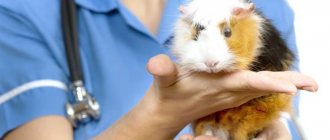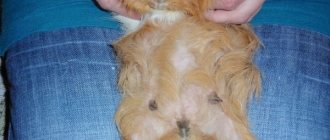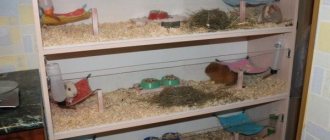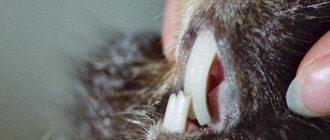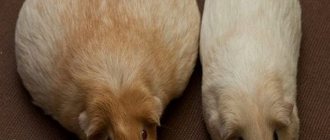Guinea pigs are animals that were bred by the Inca tribes living in South America in the territory of modern Peru and Bolivia. They still exist there in the wild. Selection work has made it possible to obtain many decorative breeds of guinea pigs that live with people and require care and attention. If your guinea pig gets sick, your veterinarian will help you understand the cause of the disease and provide treatment.
Guinea pigs are animals that were bred by the Inca tribes living in South America in the territory of modern Peru and Bolivia. They still exist there in the wild. Selection work has made it possible to obtain many decorative breeds of guinea pigs that live with people and require care and attention. If your guinea pig gets sick, your veterinarian will help you understand the cause of the disease and provide treatment.
Why do guinea pigs get sick?
Diseases in guinea pigs are associated with poor diet, infections and lack of vitamins. These can be infectious diseases that affect the animal’s body, getting to it with food and water. Another cause of disease lies in improper feeding. Some foods can cause intestinal upset, and its long-term manifestations result in the death of the animal. The third reason is the structural features of her body, which should be taken into account during care. Treatment by a veterinarian prolongs the life of your pet.
The peculiarity of these rodents is their long intestines, which become upset after a change in diet, and teeth, which grow throughout their lives and require constant grinding. They need to be fed hay every day to keep their teeth and intestines normal. The body of these animals does not absorb vitamins well, so special attention should be paid to the food. These ancient animals cannot tolerate penicillin, which becomes a deadly poison for them. Therefore, moldy food is not suitable for them. Guinea pigs need to chew something constantly to keep their digestive system healthy. These rodents live up to seven years, and those who live in a pack live longer than solitary individuals.
How to treat your pet for a cold
A sick animal should not be treated independently, but rather shown to a veterinarian. But some actions can be performed before visiting a veterinarian. A stuffy nose should be rinsed. To do this, the animal must be placed on its back and a drop of chlorhexidine and Derinat children's drops should be placed into the nostrils to increase immunity.
Also find out where the name "guinea pig" comes from.
After instillation, wipe the nose with a piece of bandage or gauze, and put the pig on its paws. This procedure is done three times a day, preferably with a partner. After it, the animal begins to sneeze, and the nasal cavity is cleared. Then it is recommended to blow Streptocide powder into the nostrils.
If inflammation of the eyes is observed, they are washed with boiled water and instilled with anti-inflammatory drops (for example, “Tsiprovet”). The sick animal is prescribed vitamins, medicinal decoctions and anti-inflammatory drugs. Usually these are sulfonamides. Treatment largely depends on how advanced the infection is.
What to feed your guinea pig?
The problem of feeding a guinea pig worries everyone who brings the animal home. Guinea pigs eat constantly in small portions, so the food should be available to them constantly, but it needs to be refreshed 3 times a day. Grain feeds increase excess weight and lead to obesity, so they are limited to the norm. Be sure to have a piece of well-dried dry grass, branches of fruit trees, and willow in the cage. A guinea pig's teeth grow throughout their life, and hard foods help to wear them down in captivity. To prevent the pig from getting sick, there should always be food in the cage.
Give succulent food to pigs in the morning. You should not give potatoes that the body cannot digest. Carrots, celery, cabbage, beets, pumpkin, and sweet peppers should be given by cutting them into pieces. The norm is 160 grams. For pregnant, lactating and Skinny women, the dose is doubled and divided into two doses: one in the morning, the other in the evening.
The volume of the animal's drinking bowl should be 250 ml. Vitamin C is added to the water in an amount of 2.5-5 mg per glass of water. In summer a minimal dose is sufficient, in winter a larger dose is sufficient. If the animal receives a premix of vitamins in the finished feed, then this is enough.
Berries and fruits are given as a treat in small quantities in the first half of the day. These could be apples, pears, dry rose hips.
Herbs such as red clover, dandelion, plantain, nettle, chamomile, and yarrow are very beneficial for the animal and can be dried for the winter. Parsley, dill, leaf celery - these herbs are not given to pregnant animals. Spinach and lettuce are only those that grew in the open ground in the summer. An excess of fertilizers in greenhouses leads to the accumulation of harmful substances in plants, which can poison the animal. Salt is given to young animals per 1 animal 0.5 g, to adults - 1 - 2 g.
If your pig is breathing heavily and wheezing
A cough does not always indicate diseases of the bronchopulmonary system. Sometimes this indicates cardiac pathology.
The animal needs quick help and advice from a specialist.
Symptoms of heart failure:
- The pig gasps for air;
- breathing heavily;
- periodic coughing;
- shortness of breath when moving;
- immobility develops;
- lethargy and apathy;
- paws are cool;
- fingers turn blue;
- coordination of movements is impaired;
- convulsions.
To stop heart and asthmatic attacks, you need to immediately drop 2 drops of Corvalol into the mouth and then let the animal smell cotton wool soaked in aroma oil. The animal is given an injection that includes aminophylline, dexamethasone, and furosemide.
They treat heart failure for a long time, maintaining vitality.
Heart drops are administered to the rodent using an insulin syringe with the needle removed.
An animal suffering from heart failure needs proper nutrition and good living conditions.
The first signs of the disease
Sick animals huddle in a corner or sit in a house and don’t go out anywhere. Lethargy, watery eyes, refusal to eat, intestinal upset are signs that require attention from the owner. Heavy or fast breathing, slow tousled fur, elevated body temperature over 39.6 indicate that the rodent is sick. If a guinea pig is sick, the owner can provide first aid to it, and then show the animal to a doctor. To provide first aid you must have: hydrogen peroxide, potassium permanganate, activated carbon. It is also good to have a transport cage for carrying the animal. It is better not to give her dosage forms yourself, because the dose calculation depends on the weight of the animal and is carried out according to special tables that are known to specialists. It is not possible to calculate the drug yourself. The pig can die from an overdose. Entrust treatment to a veterinarian.
Possible causes of a cold in an animal
Guinea pigs have a good immune system. But it largely depends on the quality of food that this animal consumes. The food must be of good quality and contain all the vitamin complexes necessary for the animal (C, A, and so on).
Possible causes of colds in this rodent may be:
- Hypothermia. The air temperature in the room where this animal is kept should be more than +18ºС.
- Drafts. The cage must be located in a quiet place where there are no drafts and the air conditioner is not blowing.
- Bathing. After this procedure, the wool should be thoroughly wiped. You can even dry it a little with a hairdryer.
- Litter. Poor quality filler, as well as extremely rare replacement. Wet litter should be removed as needed.
Did you know? Guinea pigs became pets about 5 thousand years ago in South America. They were domesticated by tribes living in the Andes.
We measure the temperature
The guinea pig does not like to be forced and tries to escape. To hold her during inspection, you need to turn her paws up and hold her by the fur on the back of her head. In this position, her temperature is measured with a special veterinary or an ordinary thermometer in the anus. To measure it, the pig is placed with its back on the palm of the left hand or on a surface. Press the thumb of the left hand on the groin. With the right hand, a thermometer, disinfected and lubricated with Vaseline, is inserted into the rectum. It is introduced in two stages: first almost vertically, and then in a horizontal position so as to completely hide the thermometer nose. Hold the animal tightly during the entire temperature measurement procedure, which lasts about a minute.
Associated symptoms (and their explanation)
The following accompanying symptoms (and their explanation) are extremely important. If they are interpreted correctly, they can save your pet's life or significantly speed up its recovery in the future.
Snot, nasal discharge
As a rule, snot and nasal discharge may indicate:
- Colds. In this case, the mucus is an inflammatory exudate.
- Allergies. In this case, it is rather not snot that is released from the nose, but a liquid, transparent exudate. This also indicates the onset of the inflammatory process.
- Snot may be a response to large amounts of dust entering the respiratory tract. The body tries to flush out excess from the upper respiratory tract.
- Presence of a foreign body. As in the previous case, the body tries to create conditions for the natural removal of waste.
Sneezing without snot from the nose
If the animal just has sneezing, without snot from the nose, then this may be a sign of:
- The presence of a large amount of dust in the air, when its particles irritate the mucous membranes of the respiratory tract.
- This happens when allergies or a cold begin, but soon snot (as a result of inflammation) will still appear.
- It is possible that something got into the pig’s nose, but this “something” has already safely flew out when sneezing.
Independent initial examination of the mumps
- Lice and lice that infect the skin cause the rodent to itch. Scratching and wounds on the body are also a reason to consult a veterinarian.
- The fur near the anus can only be dirty due to an intestinal disorder.
- The nasal mucosa of a healthy pig is clean, but a sick pig has discharge, both fresh and dried.
- A healthy guinea pig's eyes are clear and shiny. If there is pus and inflammation, then this is evidence of illness.
- The ear openings show signs of inflammation - you should consult a doctor.
Diagnostic methods
Often the diagnostic methods used are not particularly diverse. The veterinarian collects a detailed medical history. It is important for the specialist to know whether the animal received new types of food, whether there were any cases of hypothermia, etc.
But still, an accurate diagnosis can only be made on the basis of a full clinical examination of mumps:
- A phonendoscopy is performed (the pet's chest cavity is listened to).
- If necessary and if an infection is suspected, a complete blood test, microscopy and serology (usually an ELISA reaction) are performed.
- Discharge from the nose and eyes is examined under a microscope.
- In doubtful cases, the resulting material is sown on nutrient media in order to accurately identify the type of pathogenic microorganism.
Diseases caused by vitamin deficiency and viruses
- Vitamin deficiency in guinea pigs causes diseases such as scurvy, focal baldness, allergic reaction, itchy skin, decreased immunity and colds.
- Conjunctivitis is a purulent inflammation of the mucous membrane of the eyelids, which often accompanies excessive growth of molars, keeping the animal in a dusty room, due to chemical irritants. First, the animal's eyes become swollen and red, then the appearance of pus causes the eyelashes to stick together and tearing increases. Then the eyelids completely stick together from pus and if the disease is not treated, the mumps will go blind. It is advisable not to self-medicate for conjunctivitis because it may be an indirect sign of a cold that will turn into pneumonia or an indirect sign of overgrown teeth. Remember to practice good personal hygiene and wash your hands after treating your pet.
- Rickets occurs due to a lack of calcium and vitamin D. It usually occurs in young pigs in winter. They recommend a trivitamin, irradiation with a quartz lamp, and adding salt to the diet. With rickets, the limbs are twisted, the joints are thickened, the animal is depressed and stunted.
- Paratyphoid fever is an infectious disease that begins due to damage to the pig's body by microorganisms that enter with drinking water and feed. A sick animal refuses food, its fur becomes sticky, and its eyes become dull. Antibiotic treatment is prescribed only by a doctor.
- Pasteurellosis causes a runny nose. The disease begins with moistening of the hairs around the nostrils, then sneezing appears. The nose itches and the animal rubs it with its paws. Then mucus appears from the nose, turning into pus. The pig's breathing becomes heavy and wheezing. All this is accompanied by decreased appetite and lethargy. The disease is chronic and lasts a long time. During an exacerbation, ulcers appear on the body, high fever and convulsions rise. Pasteurellosis cannot be cured. Animals with severe symptoms of the disease are euthanized. At the beginning of the disease, when the symptoms are not clear, they are treated with antibiotics and sulfa drugs.
- Wounds can occur in the event of a fight with a relative or an attack on an animal by a cat or dog. The hair around the wounds is cut off, the wound is washed and dried using hydrogen peroxide or a solution of potassium permanganate in a ratio of 1:1000. Then it is lubricated with Levomekol, synthomycin or streptocyte ointment until it is completely cured.
- Fractures and cracks in bones occur during a fall. Swelling occurs at the site of injury, and there may be muscle damage with an open fracture. There is always severe pain. The animal will limp for the rest of its life. The fracture must be treated in a clinic.
- Diseases of the digestive system are associated with the structural features of the intestines. In rodents it is very long, and food takes a long time to digest in it. Changing feeds and an excess of juicy vegetables leads to intestinal upset and diarrhea. The owner of a rodent should know that the introduction of new food should begin with minimal portions, in the morning, with a gradual increase and replacement of the usual diet. This is done when absolutely necessary. Or with the change of season, when you need to introduce fresh grass into your diet. To correct nutritional errors, give activated carbon and a weak pink solution of potassium permanganate instead of drinking.
- Flatulence requires examination by a veterinarian. The formation of gases in the colon area often causes disturbances in the functioning of the respiratory and cardiovascular systems. In rodents, this disease leads to death from suffocation or cardiac arrest. You can relieve flatulence with massage or gymnastics. The animal must be released to run around.
- Infection of the salivary gland with cytomegalovirus and herpes virus occurs through water. In some cases, guinea pigs develop a fever and increased drooling. After some time, the immune system expels the virus and the disease goes away. Re-infection is excluded, since antibodies against these viruses have appeared in the body.
- Enteritis is accompanied by diarrhea, bloating and loud rumbling in the intestines; with these signs, the rodent should be urgently taken to the veterinarian. The cause may be moldy feed. A urine test is taken, which shows the presence of ketone bodies. Treatment of enterocolitis involves restoring the intestinal microflora. To do this, exclude all feed except high-quality hay. In summer, you can collect yarrow, chamomile, red clover, plantain, nettle, dry the herbs on an iron tray and feed this to the animal for 3 days. Glucose is added to the water, dissolved feces from healthy pigs are given, which improves the intestinal microflora. It is diluted in water and injected into the oral cavity through a syringe once a day. There is no need to prevent pigs from eating their own droppings. This will only benefit them. The list of diseases can be kept endlessly, but only a veterinarian can make the correct diagnosis.
Any disease with fever, accompanied by pain and discharge requires the attention of a veterinarian. Call the phone number listed on the website and ask all your questions.
The main causes of sneezing: norm and deviations
You need to start with cases when you don’t need to worry about your pet’s health:
- Sneezing can be caused by common dust. If your pet starts sneezing uncontrollably while cleaning the room, this only indicates that you need to do wet cleaning more often.
- Reaction to perfume or other cosmetics. Because of this, by the way, there is no need to place a cage with a pet near tables with cosmetics and household chemicals.
- Pigs often react by sneezing to a portion of fresh hay, new litter, new food, etc. In these cases, the reasons vary from the same dust (which is especially abundant in hay) to allergies.
It is necessary to call a veterinarian in the following cases:
- The sneezing is sharp, strong, as if the mumps are “throwing up”, the frequency of attacks increases.
- It is accompanied by severe wheezing, hissing, and other signs that something is wrong.
- Mucus or blood is released from the animal's nose.
- After bouts of sneezing, the pet lies on its back or side, opens its mouth wide and sucks in air noisily.
- You urgently need to call a specialist when your pet begins to swell and its visible mucous membranes (including those on the nose and eyes) turn blue. This indicates a severe lack of oxygen.
Non-communicable diseases
Below are descriptions with photos of the main non-infectious pathologies characteristic of mumps.
- Cystitis. A pig suffering from cystitis is anxious, does not go to the toilet, and does not drink water. Attempts to empty the bladder cause pain, and blood is noticeable in the urine. Treatment is carried out with antibiotics and antispasmodics.
- Ovarian cyst. The disease is asymptomatic and therefore often leads to death. In rare cases, a sick pig will shed on both sides of the body. A cyst can only be detected through ultrasound. The only treatment method is surgical removal. The tumor is excised along with the uterus and appendages.
- Injuries. Why do pet pigs get wounds and scratches? The fact is that rodents, especially those living crowdedly, often sort things out, bite and scratch each other. The animal can also scratch its skin on the bars of the cage or damage the soles of its paws on the grated floor. Calluses and abscesses are visible on damaged paw pads. The animal staggers when walking, prefers to lie down, and you can notice that its paw is swollen. To avoid an abscess, the wound should be washed daily with a solution of potassium permanganate or 3% hydrogen peroxide, treated with Streptomycin ointment or Vishnevsky ointment, and covered with a bandage. The bottom of the cage should be solid, not lattice.
- Pododermatitis. Inflammatory disease of the heels in pigs, often leading to death. A sick animal limps, its paws become bald, its pads become swollen, red, and covered with ulcers. What causes the disease? The main reasons are vitamin deficiency, poor sanitary condition of the cage, foot fungus, obesity and a sedentary lifestyle. Treatment is carried out with Levomikol ointment for wound suppuration, Dermatol powder for ulcers, and Topic spray for bleeding.
- Rickets. Caused by vitamin deficiency, poor quality diet, lack of sun. A sick pig has a perverted taste: it chews bedding, cage bars, toys. In advanced cases, the animal’s legs and spine become bent, joints thicken, and convulsions occur. The fur becomes dull, clumps, and dandruff appears. What to feed your pet to get rid of rickets? It is necessary to give more hay and fresh greens, add vitamins and minerals, especially calcium, to the food. If a pig drinks a lot of water, then it does not have enough succulent food.
- Heart diseases. Stroke, myocardial necrosis and other diseases of the cardiovascular system are rare in pigs. Heart function is disrupted mainly due to stress and uncomfortable temperature conditions. To prevent your pet from getting sick, it should live in a quiet and shaded place where the air temperature ranges from 22 to 25°C.
- Eye diseases. A pig's eye usually becomes infected with conjunctivitis. You may notice that the pet squints, is afraid of the light, his eye is swollen, tears and pus flow, and crusts appear on the eyelids. If the infection spreads to the muzzle, cheilitis develops. Treatment is prescribed by a veterinarian based on the cause of conjunctivitis. When the cornea is injured, keratitis develops. The cornea becomes cloudy, and the rodent's vision weakens. Therapy is carried out with antibiotic drops. Sometimes you may notice white discharge from your pig's eyes. These are tears. The animal is stressed, scared and crying.
- Otitis. When the ears are inflamed, the pig becomes nervous, shows aggression, lowers its head to the side or down, and shakes it. A crust of dried blood is noticeable inside the sore ear. What to do if your pet has otitis media? Surolan is instilled into the ears; it is additionally recommended to treat the ears with Miramistin or Chlorhexidine.
- Tumors. Most often, rodents develop cancer of the mammary glands and skin. A malignant tumor forms on the abdomen or back and looks like a lump. Rarely, the neoplasm appears as a spot on the hind legs. Oncology is excised without consequences, but cancer on the hind legs can metastasize. A tumor on the neck or back may turn out to be a harmless wen - a lipoma.

